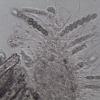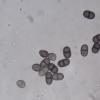
12-08-2015 21:57
Lepista ZacariasDear all,Can you help in identifying this ascomyce

15-08-2015 16:14
 Blasco Rafael
Blasco Rafael
Hola, he visto esta Sporormiella sobre excremento

14-08-2015 00:43
We have had a lot of dry weather lately and a log

14-08-2015 10:09
de pequeño tamañoNo se por donde comenzarJoseba

14-08-2015 01:00
Bonjour ! Je viens d'étudier Pulvinula carbonari

14-08-2015 10:13
estas pequeñas setas, a las que no he apreci

22-08-2014 18:01
 Bernard Declercq
Bernard Declercq
Hallo to everybody,Does anyone have following docu
Ascomycete on Juniperus wood
Lepista Zacarias,
12-08-2015 21:57
Can you help in identifying this ascomycete growing on the wood of Juniperus?
These shrubs are the only vegetation at a cliff over the sea. Here are some data about the ascomycete:
- All parts with negative reaction to melzer;
- Asci unitunicate, 8-spored, with dimensions up to 85 x 13 um;
- Spores first hialine, soon grey-brwon, 1-septate with dimensions
(13.7) 14.2 - 16.6 (17.3) x (8.4) 8.7 - 9.9 (10.6) um
Q = (1.5) 1.53 - 1.87 (1.9) ; N = 28; Me = 15.3 x 9.2 um ; Qe = 1.7.
I attach some photos of the specimen and the corresponding microscopy.
Thanks in advance,
zaca
Lepista Zacarias,
14-08-2015 22:13
Re : Ascomycete on Juniperus wood
Any hint about this one?
Thanks,
zaca
Thanks,
zaca
Alain GARDIENNET,
15-08-2015 21:39
Re : Ascomycete on Juniperus wood
Could it be lichenized ?
Lepista Zacarias,
15-08-2015 21:42
Re : Ascomycete on Juniperus wood
No trace of alga was found in the slide.
Thanks, Alain, for your question.
Regards,
zaca
Thanks, Alain, for your question.
Regards,
zaca




